1995 PONTIAC BONNEVILLE heating
[x] Cancel search: heatingPage 178 of 338
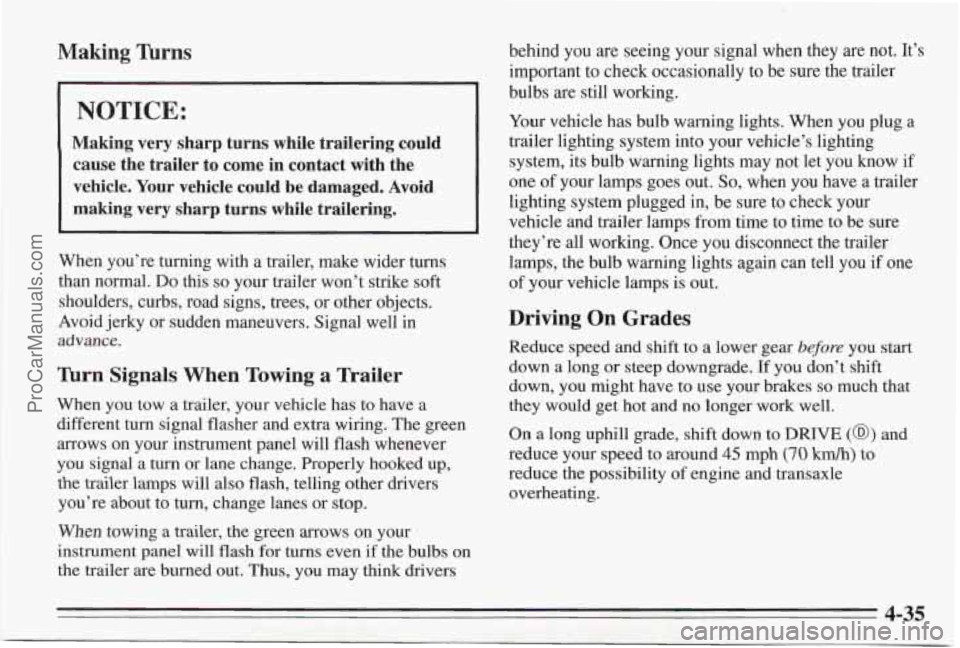
Making Thms
NOTICE:
Making very sharp turns while trailering could cause the trailer to come in contact with the vehicle. Your vehicle could be damaged. Avoid
making very sharp turns while trailering.
When you’re turning with a trailer, make wider turns
than normal.
Do this so your trailer won’t strike soft
shoulders, curbs, road signs, trees, or other objects.
Avoid jerky or sudden maneuvers. Signal well in
Tldvance.
’Ibrn Signals When Towing a Trailer
When you tow a trailer, your vehicle has to have a
different turn signal flasher and extra wiring. The green
arrows on your instrument panel will flash whenever
you signal a turn or lane change. Properly hooked up,
the trailer lamps will also flash, telling other drivers
you’re about to turn, change lanes or stop.
When towing a trailer, the green arrows on your
instrument panel will flash for turns even if the bulbs on
the trailer are burned out.
Thus, you may think drivers behind
you are seeing your signal when they are not. It’s
important to check occasionally to be sure the trailer
bulbs are still working.
Your vehicle has bulb warning lights. When you plug a
trailer lighting system into your vehicle’s lighting
system, its bulb warning lights may not let you know if
one of your lamps goes out.
So, when you have a trailer
lighting system plugged in, be sure to check your
vehicle and trailer lamps from time to time to be sure
they’re all working. Once you disconnect the trailer lamps, the bulb warning lights again can tell you if one
of your vehicle larnps is out.
Driving On Grades
Reduce speed and shift to a lower gear before you start
down a long or steep downgrade.
If you don’t shift
down, you might have to use your brakes
so much that
they would get hot and
no longer work well.
On a long uphill grade, shift down to DRIVE (@) and
reduce your speed to around 45 mph (70 kmph) to
reduce the possibility of engine and transaxle
overheating.
ProCarManuals.com
Page 191 of 338
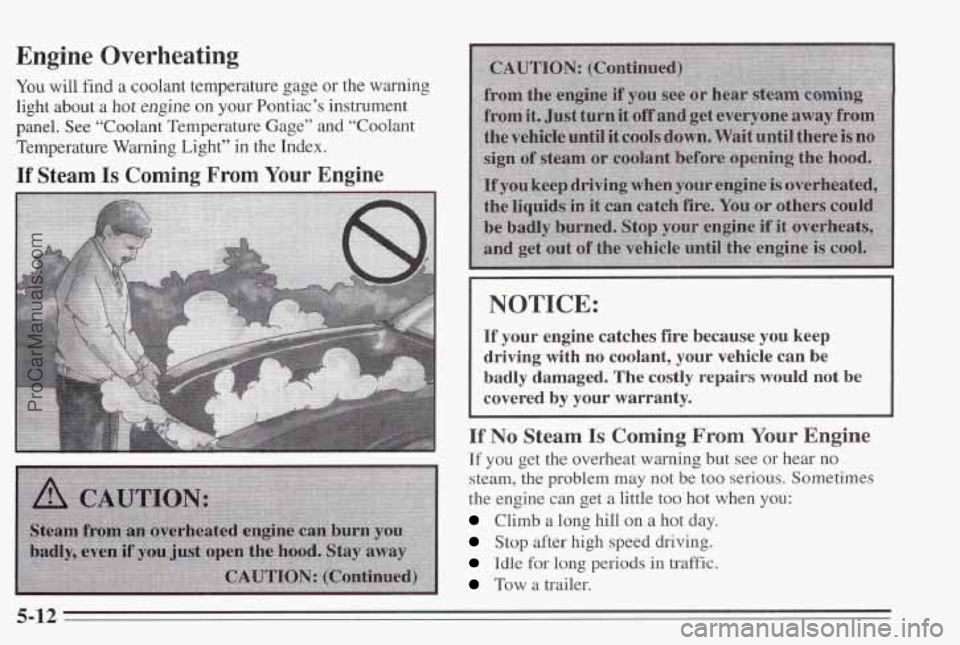
Engine Overheating
You will find a coolant temperature gage or the warning
light about a hot
engine on your Pontiac’s instrument
panel. See “Coolant Temperature Gage” and “Coolant
Temperature Warning Light”
in the Index.
If Steam Is Coming From Your Engine
I NOTICE:
If your engine catches fire because you keep
driving with no coolant, your vehicle can be
badly damaged. The costly repairs would not be
covered by your warranty.
If No Steam Is Coming From Your Engine
If you get the overheat warning but see or hear no
steam,
the problem may not be too serious. Sometimes
the engine can get a little too hot when
you:
Climb a long hill on a hot day.
Stop after high speed driving.
Idle for long periods in traffic.
Tow a trailer.
5-12
ProCarManuals.com
Page 193 of 338
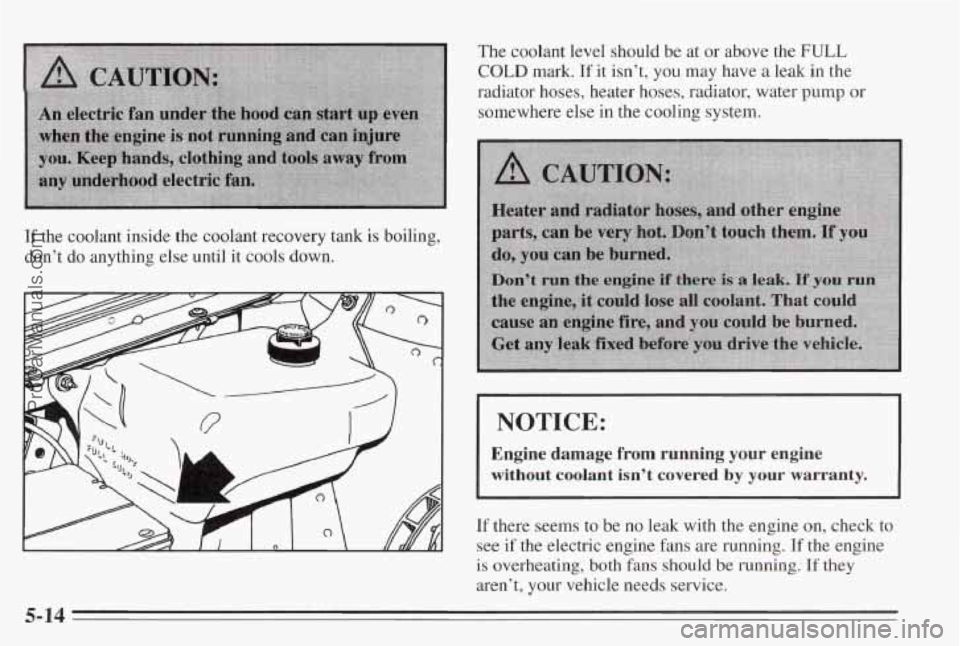
If the coolant inside the coolant recovery tank is boiling,
don’t
do anything else until it cools down.
The coolant level should be at or above the FULL
COLD mark. If it isn’t, you may have a leak in the
radiator hoses, heater hoses, radiator, water
pump or
somewhere else in the cooling system.
NOTICE:
Engine damage from running your engine
without coolant isn’t covered by your warranty.
If there seems to be no leak with the engine an, check to
see if the electric engine fans are running. If the engine
is overheating, both fans should be running. If they
aren’t,
your vehicle needs service.
5-14
ProCarManuals.com
Page 235 of 338
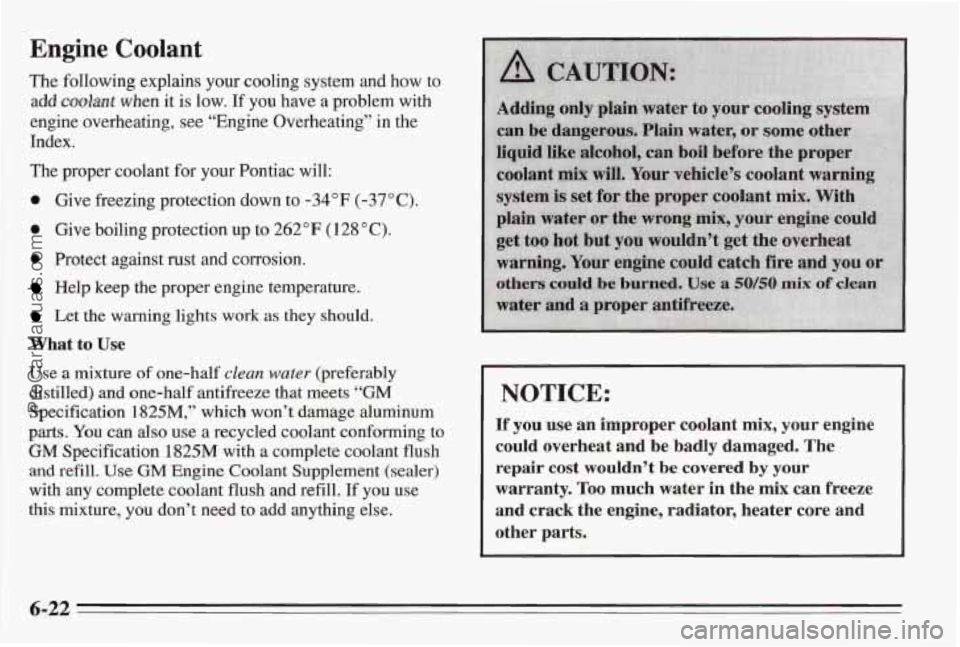
Engine Coolant
The following explains your cooling system and how to
add
coolant when it is low. If you have a problem with
engine overheating, see “Engine Overheating” in the
Index.
The proper co’olant for your Pontiac will:
0 Give freezing protection down to -34°F (-37°C).
0 Give boiling protection up to 262°F (128 “C).
0 Protect against rust and corrosion.
Help keep the proper engine temperature.
Let the warning Sights work as they should.
What to Use
Use a mixture of one-half clean water (preferably
distilled) and one-half antifreeze that meets
“GM
Specification 1825M,?’ which won’t damage aluminum
parts. You can also use a recycled coolant conforming to
GM specification 1825M with a complete coolant flush
and refill. Use GM Engine Coolant Supplement (sealer)
with
any complete coolant flush and refill. If you use
this mixture,
you don’t need to add anything else.
NOTICE:
If you use an improper coolant nrsix, yuur engine
could overheat and be badly damaged. The
repair cast wouldn’t be mvmd by your
warranty. T~o much water in the mix em freeze
and crack the engine, radiabl; heater core an’d
other
pa
6-22
ProCarManuals.com
Page 237 of 338
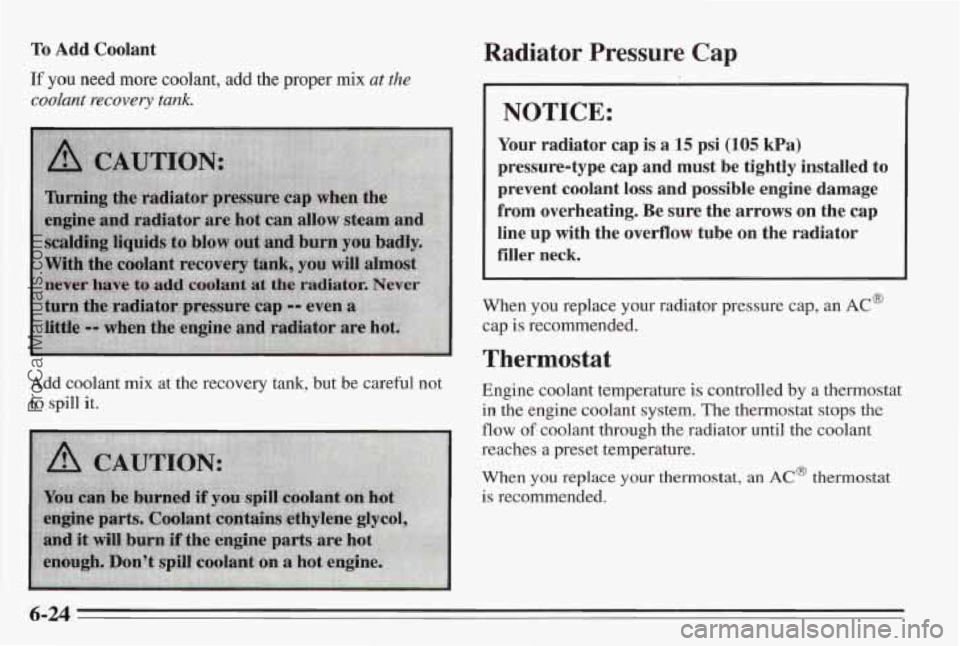
To Add Coolant
If you need more coolant, add the proper mix at the
coolant recovery tank.
Add coolant mix at the recovery tank, but be careful not
to spill it.
Radiator Pressure Cap
NOTICE:
Your radiator cap is a 15 psi (105 kPa)
pressure-type cap and must be tightly installed to
prevent coolant
loss and possible engine damage
from overheating. Be sure the arrows on the cap
line up with the overflow tube on the radiator
filler neck.
When you replace your radiator pressure cap, an AC@
cap is recommended.
Thermostat
Engine coolant temperature is controlled by a thermostat
in the engine coolant system. The thermostat stops
the
flow of coolant through the radiator until the coolant
reaches a preset temperature.
When you replace your thermostat, an AC@ thermostat
is recommended.
6-24
ProCarManuals.com
Page 329 of 338
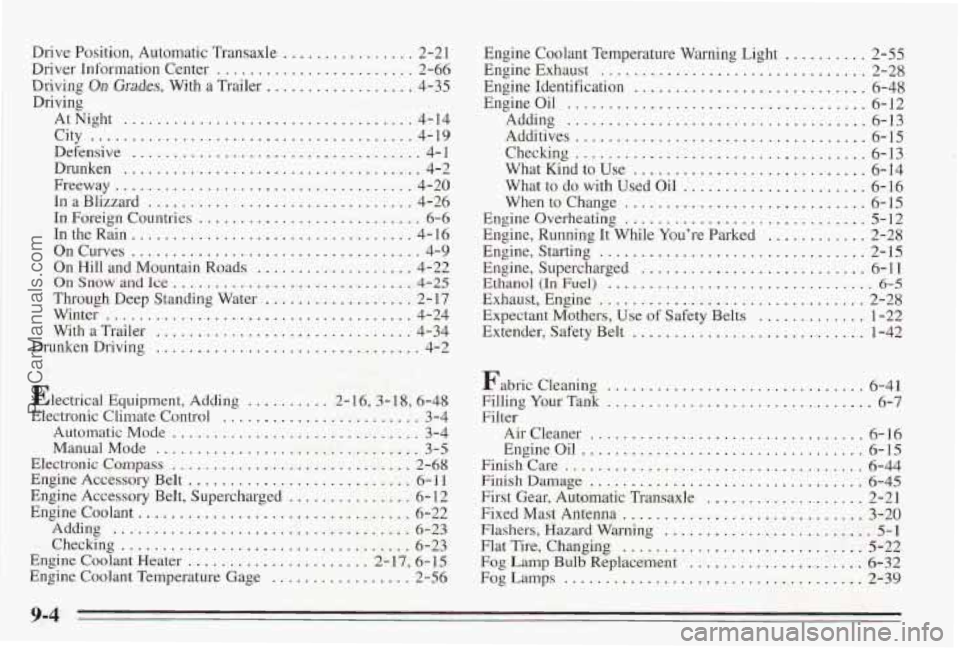
Drive Position. Automatic Transaxle ................ 2-21
Driver Information Center
........................ 2-66
Driving
On Grades. With a Trailer .................. 4-35
Driving AtNight
................................... 4-14
City
....................................... 4-19
Defensive
................................... 4-1
Drunken
.................................... 4-2
Freeway
.................................... 4-20
In a Blizzard ................................ 4-26
In Foreign Countries ........................... 6-6
In the Rain .................................. 4- 16
OnCurves
................................... 4-9
On Hill and Mountain Roads
................... 4-22
On Snow and Ice ............................. 4-25
Through Deep Standing Water .................. 2-17
Winter
..................................... 4-24
With a Trailer
............................... 4-34
Drunken Driving
................................ 4-2
Electrical Equipment, Adding
.......... 2-16, 3-18, 6-48
Electronic Climate Control
........................ 3-4
Automatic Mode
.............................. 3-4
ManualMode
................................ 3-5
Electronic Compass
............................. 2-68
Engine Accessory Belt
........................... 6- 11
Engine Accessory Belt, Supercharged ............... 6- 12
Engine Coolant
................................. 6-22
Checking ................................... 6-23
Engine Coolant Heater
...................... 2-17, 6-15
Adding
.................................... 6-23
Engine Coolant Temperature Gage
................. 2-56 Engine
Coolant Temperature Warning Light
.......... 2-55
Engine Exhaust ................................ 2-28
Engine Identification
............................ 6-48
Engineoil
.................................... 6-12
Adding
.................................... 6-13
Additives
................................... 6-15
Checking
................................... 6-13
What Kind to Use ............................ 6-14
What to do with Used Oil
...................... 6-16
Whentochange
............................. 6-15
Engine Overheating ............................. 5-12
Engine, Running It While You’re Parked
............ 2-28
Engine, Starting
................................ 2-15
Engine, Supercharged
........................... 6-11
Ethanol (In Fuel) ................................ 6-5
Exhaust, Engine ................................ 2-28
Expectant Mothers, Use of Safety Belts ............. 1-22
Extender, Safety Belt ............................ 1-42
Fabric Cleaning
............................... 6-41
FillingYourTank
................................ 6-7
Fi 1 ter Aircleaner
................................. 6-16
EngineOil .................................. 6-15
Finishcare
.................................... 6-44
Finish Damage ................................. 6-45
First Gear, Automatic Transaxle
................... 2-21
Fixed Mast Antenna
............................. 3-20
Flat Tire, Changing
............................. 5-22
Fog Lamp
Bulb Replacement ..................... 6-32
Flashers, Hazard Warning ......................... 5-1
FogLamps .................................... 2-39
9-4
ProCarManuals.com